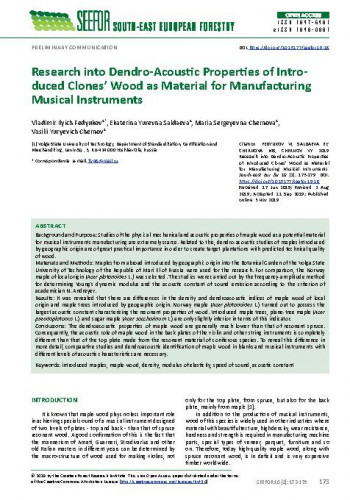Background and Purpose: Studies of the physical-mechanical and acoustic properties of maple wood as a potential material for musical instruments manufacturing are extremely scarce. Related to this, dendro-acoustic studies of maples introduced by geographic origin are of great practical importance in order to create target plantations with predicted technical quality of wood. Materials and Methods: Maples from abroad introduced by geographic origin into the Botanical Garden of the Volga State University of Technology of the Republic of Mari El of Russia were used for the research. For comparison, the Norway maple of local origin (Acer platanoides L.) was selected. The studies were carried out by the frequency-amplitude method for determining Young's dynamic modulus and the acoustic constant of sound emission according to the criterion of academician N. Andreyev. Results: It was revealed that there are differences in the density and dendroacoustic indices of maple wood of local origin and maple trees introduced by geographic origin. Norway maple (Acer platanoides L.) turned out to possess the largest acoustic constant characterizing the resonant properties of wood. Introduced maple trees, plane-tree maple (Acer pseudoplatanus L.) and sugar maple (Acer saccharinum L.) are only slightly inferior in terms of this indicator. Conclusions: The dendroacoustic properties of maple wood are generally much lower than that of resonant spruce. Consequently, the acoustic role of maple wood in the back plates of the violin and other string instruments is completely different than that of the top plate made from the resonant material of coniferous species. To reveal this difference in more detail, comparative studies and dendroacoustic identification of maple wood in blanks and musical instruments with different levels of acoustic characteristics are necessary.
Sažetak

 South-east European forestry : SEEFOR : international scientific journal in field of forestry : 10,2(2019) / editor-in-chief Dijana Vuletić.
South-east European forestry : SEEFOR : international scientific journal in field of forestry : 10,2(2019) / editor-in-chief Dijana Vuletić.